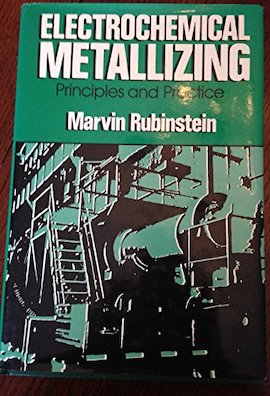
-----
Material of construction for brush plating anodes
Q. Why does the plating community seem to always demand 316 CRES as opposed to 304, 321, 347, or any other stainless available?
Eric Alstadhobbyist - Killeen, Texas
July 30, 2009
Electrochemical Metallizing by Marv Rubinstein

on eBay or Amazon
or AbeBooks
(affil link)
Hi, Eric. Why do you want to buy, sell, or use 304, 321, or 347 anodes? I'm not trying to be a wise guy; just hinting that if you mention your situation, your question will probably be answered; whereas, when a question is abstract, readers often find it hard to reply and so remain silent.
Thanks!
Regards,

Ted Mooney, P.E.
Striving to live Aloha
finishing.com - Pine Beach, New Jersey
Ted is available for instant help
or longer-term assistance.
July 30, 2009
July 31, 2009
Q. Thanks for your response Ted. First off I'm not here to buy or sell anything. I was a machinist and tool and die maker back in the 70's (aerospace) I've worked with all types of exotic alloys and was just curious. I'm retired now and need a new hobby.
On Vehicle Gold Plating Car/Motorcycle Emblems.
I have an Epsco 25 amp plater and a dual output 30 v 5 a power supply.
My questions lie in the anode material and anode wraps or cover material.
316 is fine with me,I don't really care. I can make them out of anything I want including titanium.
As far as the anode wraps.
I purchased some from various suppliers and was extremely disappointed with what I received.
What is a good material for stripping and what is a good material cover for plating?
I realize the current flow determines the stripping and plating, but I think the fabric would also play a part in the process.
I live in a town that has nothing available except what you can buy at Wal-mart.
It's easier for me to make what I need as opposed to being subject to internet purchases.
Thanks,
hobbyist - Killeen, Texas
A. My answer is even more simple than Ted's.
They found out a long time ago that the anode lasts longer so in the long run is cheaper and less hassle. The reason is the small amount of Mo added to the alloy.
You can use whatever floats your boat. Special graphite is another common material for anodes.
- Navarre, Florida
July 31, 2009
A. Heavy double-knit polyester makes excellent anode covers. Most fabric shops will have some, but if not, dig out one of those bell-bottom leisure suits from the 70s.

Jeffrey Holmes, CEF
Spartanburg, South Carolina
August 26, 2009
A. Wrap the anode with a bit of cotton batting, cover that with a couple wraps of tube gauze and then you can use anything that is compatible with the different solutions. I liked napped polypropylene, looks cheap but works fine. I made a lot of my own after I saw what worked.
You need a different anode for each one of your solutions.
A big secret to brush plating is to rinse rapidly and start with the next solution. Keep the part wet at all times or it will oxidize.(and peel)
- Navarre, Florida
August 28, 2009
A. Alternatively, for soft metals, thin coatings and bright finishes like emblems, you can use white scotch-brite pads cut to size and wrapped with plastic cords.
Guillermo MarrufoMonterrey, NL, Mexico
September 2, 2009
Q, A, or Comment on THIS thread -or- Start a NEW Thread